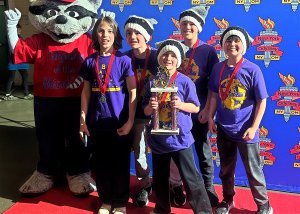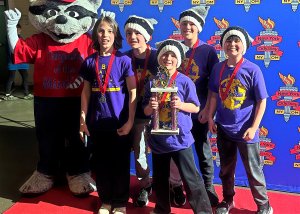In my last article, I wrote about the importance of strength training for runners. Today I would like to go a bit deeper and talk about runner’s strengthening their “core.” This is a popular area of concern and I often hear, “I know I need to work on my core,” as someone pats their belly. I would like to say that having a strong core is certainly a worthwhile pursuit, but hoping that it will lead to a body that has been photoshopped in magazines is not what most people in the healthcare field think of when talking about the core.
Let me start by defining what I think of as the “core.” I use the analogy of an apple core. Our “core” goes all the way around, just like an apple core is the front, back, and sides. So if you are interested in building a strong core, working on just your front abdominal muscles will likely not be all that helpful. Whereas working on the muscles that go all the way around the midsection (including abdominals, butt and pelvis muscles) will likely lead to more positive results.
Today I would like to expand the terminology and add the word, “functional” to core. When I am evaluating a runner, I am assessing what muscle groups play the biggest role when running...the “functional” muscles. So, when I am teaching patients how to use their “core” muscles to help recover from an injury, or how to minimize risks of more injuries, I do my best to address the functional core muscle groups. The muscles that surround the pelvis play a vital role in controlling the pelvis. These muscles are necessary for basic functions like how we sit and how we stand. But they also play an important role in how we walk and also how we run. Weakness in these muscles may result in pain or injury in the lower back, hip, and even the knee.
One of the most common exercises I use when addressing a patient’s core is the bridge. I find it helpful to address the weaknesses I notice in the “core” when patients struggle to stabilize the pelvis. This can be seen when I do a treadmill analysis and watch the runner in slow motion. Often there is an obvious drop in the pelvis or some sort of rotation that indicates pelvic instability.
I find that a typical bridge gets easy for a lot of runners fairly early so I progress them to the straight leg bridge. This exercise will often address common buttock weaknesses, but it also addresses the pelvic stabilizers. A lot of runners come with an injury to one side of their body and these muscles are often impaired either to protect us or because they are impaired they contribute to the injury in the first place.
The straight leg bridge is performed by lifting the buttock into the air and then straighten one leg as.
My cueing is to make sure that the patient will have their pelvis “square” meaning that it is not rotated or dropping on one side. This is a challenge for a lot of people because the muscles that stabilize the pelvis are often weak on one side (typically the injury side) Also, the straight leg should be at the level of the thigh. This forces the patient to work on pelvic stability and to avoid cheating.
Once the patient is able to achieve the position, I will ask them to hold for 3-5 seconds. I have found that teaching patient to reset the pelvis each time both feet are on the ground to make sure the butt is up and the pelvis is square before straightening a leg. We have a tendency to drop our butts and the goals are to stay stable throughout the entirety of the movements. These movements should be deliberate...meaning slow down!
The next movement I often recommend is a side plank from the knees with the top leg lifted up and held slightly back with the foot elevated higher than the knee. The key areas should be to focus on driving the pelvis forward so that your shoulder, hip bone, and knee remain in a straight line. The most common “cheat” is to let the butt go back and the top foot to drop. Another key point is to strive to hold the foot above the knee.
I recommend this version because it also will address a common weakness in runners’ pelvic musculature. There are a lot of people that recommend the side plank from the feet but I find there are too many possible ways to cheat in the beginning. As the patient gains strength I may progress to a straight leg side plank, but typically I add bands and top leg movements first.
I would like to use a couple specific examples to help clarify even more what I am speaking of.
The first thing to consider with running is that you do it standing up, so to address the muscles in a “functional” way we need to progress to include standing exercises. I want to have my patients learn how to build their strength in a way that is as close to the task they are attempting to do, in this case, run.
One of my favorite “abdominal” core exercises is the “Pallof Press.” There are a variety of ways to do it and typically I start patients standing with a wide base of support. The band is pulling the trunk in a rotation movement and it requires the core muscles to engage to prevent the rotation. There are a lot of runners with rotational weaknesses, you can tell if you see someone with their arms way out to the side and/or if they have a lot of trunk rotation while running.
I will often have runners do the movement in a half kneeling position. This helps to address unilateral weaknesses a bit better and the half kneeling position is a reciprocal position that is similar to the position our pelvis is in when we run.
There are a lot of runners doing clam shells out there and I use that movement early on in rehabilitation. But when you are injury free and you have been doing clam shells for more than a few weeks, I recommend progressing to a standing version of working your gluteus muscles. The lateral toe tap is a great way to address the weaknesses and to build strength. I use this movement with most runners and progress the strength of the bands to ensure maximum results.
This is performed by standing with bands around the knees. The first cue I give is to stand in an athletic position with your butt back and knees bent. Then shift your weight to one side and hold that position throughout the entire exercise. Now without moving the torso or stance leg, tap the opposite foot out to the side and slightly backward. You will feel this in the hip/butt region.
These are just a few of the exercises I will use with runners. In truth, I do my best to identify the individual’s weaknesses and build a program around that. I am doing more with weights since starting FysioFit PT and find that the more I do to progress the programs the better the results I am having. I believe that having an assessment can be very helpful for the individual to find the areas that they need to work on. If you are looking for a program to help you get stronger, remember that the core is around the entire midsection. It includes stomach and back muscles but also buttock and hip/pelvic muscles. And in general, if you find your program “easy” it is time to progress. If you have been doing your program for several weeks, months or years...it is time to progress!
At Goodemote PT we work with runners recovering from injury and at FysioFit PT we work with runners that are done with rehab and want to progress their programs. We also work with runners looking for an assessment or to build on their existing program. If you have any questions email me at This email address is being protected from spambots. You need JavaScript enabled to view it. or find me at GoodemotePT.com and/or FyisoFitPT.com.


























 How to resolve AdBlock issue?
How to resolve AdBlock issue? 









